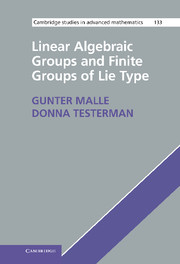Book contents
- Frontmatter
- Contents
- Preface
- List of tables
- Notation
- PART I LINEAR ALGEBRAIC GROUPS
- PART II SUBGROUP STRUCTURE AND REPRESENTATION THEORY OF SEMISIMPLE ALGEBRAIC GROUPS
- 11 BN-pairs and Bruhat decomposition
- 12 Structure of parabolic subgroups, I
- 13 Subgroups of maximal rank
- 14 Centralizers and conjugacy classes
- 15 Representations of algebraic groups
- 16 Representation theory and maximal subgroups
- 17 Structure of parabolic subgroups, II
- 18 Maximal subgroups of classical type simple algebraic groups
- 19 Maximal subgroups of exceptional type algebraic groups
- 20 Exercises for Part II
- PART III FINITE GROUPS OF LIE TYPE
- Appendix A Root systems
- Appendix B Subsystems
- Appendix C Automorphisms of root systems
- References
- Index
16 - Representation theory and maximal subgroups
from PART II - SUBGROUP STRUCTURE AND REPRESENTATION THEORY OF SEMISIMPLE ALGEBRAIC GROUPS
Published online by Cambridge University Press: 05 June 2012
- Frontmatter
- Contents
- Preface
- List of tables
- Notation
- PART I LINEAR ALGEBRAIC GROUPS
- PART II SUBGROUP STRUCTURE AND REPRESENTATION THEORY OF SEMISIMPLE ALGEBRAIC GROUPS
- 11 BN-pairs and Bruhat decomposition
- 12 Structure of parabolic subgroups, I
- 13 Subgroups of maximal rank
- 14 Centralizers and conjugacy classes
- 15 Representations of algebraic groups
- 16 Representation theory and maximal subgroups
- 17 Structure of parabolic subgroups, II
- 18 Maximal subgroups of classical type simple algebraic groups
- 19 Maximal subgroups of exceptional type algebraic groups
- 20 Exercises for Part II
- PART III FINITE GROUPS OF LIE TYPE
- Appendix A Root systems
- Appendix B Subsystems
- Appendix C Automorphisms of root systems
- References
- Index
Summary
In the previous chapter, we described the parametrization via highest weights of the irreducible representations of a semisimple linear algebraic group. There are many further questions which can be raised, for example, on extensions of simple modules and on the validity of dimension formulas in positive characteristic. In this section, we consider three aspects of the representation theory of a semisimple algebraic group G which play a particularly important role in the study of the maximal subgroups of the classical algebraic groups, namely, a criterion for the existence of a G-invariant bilinear form, the restriction of an irreducible representation to a Levi subgroup and Steinberg's tensor-product decomposition of certain irreducible highest weight modules.
Dual modules and restrictions to Levi subgroups
A faithful rational representation ρ: G → SLn identifies G with a subgroup of SLn. When is this subgroup maximal? Certainly, if ρ is not an irreducible representation, then G is contained in the stabilizer of a proper non-trivial subspace and so if G is maximal it must be the full stabilizer. Now suppose ρ is irreducible and that G stabilizes some non-degenerate form on kn, and thus lies in the isometry group of this form. Then if G is maximal it must be the full isometry group of the form. So we are led to ask when G stabilizes a non-degenerate form on a given irreducible representation.
- Type
- Chapter
- Information
- Linear Algebraic Groups and Finite Groups of Lie Type , pp. 131 - 139Publisher: Cambridge University PressPrint publication year: 2011



